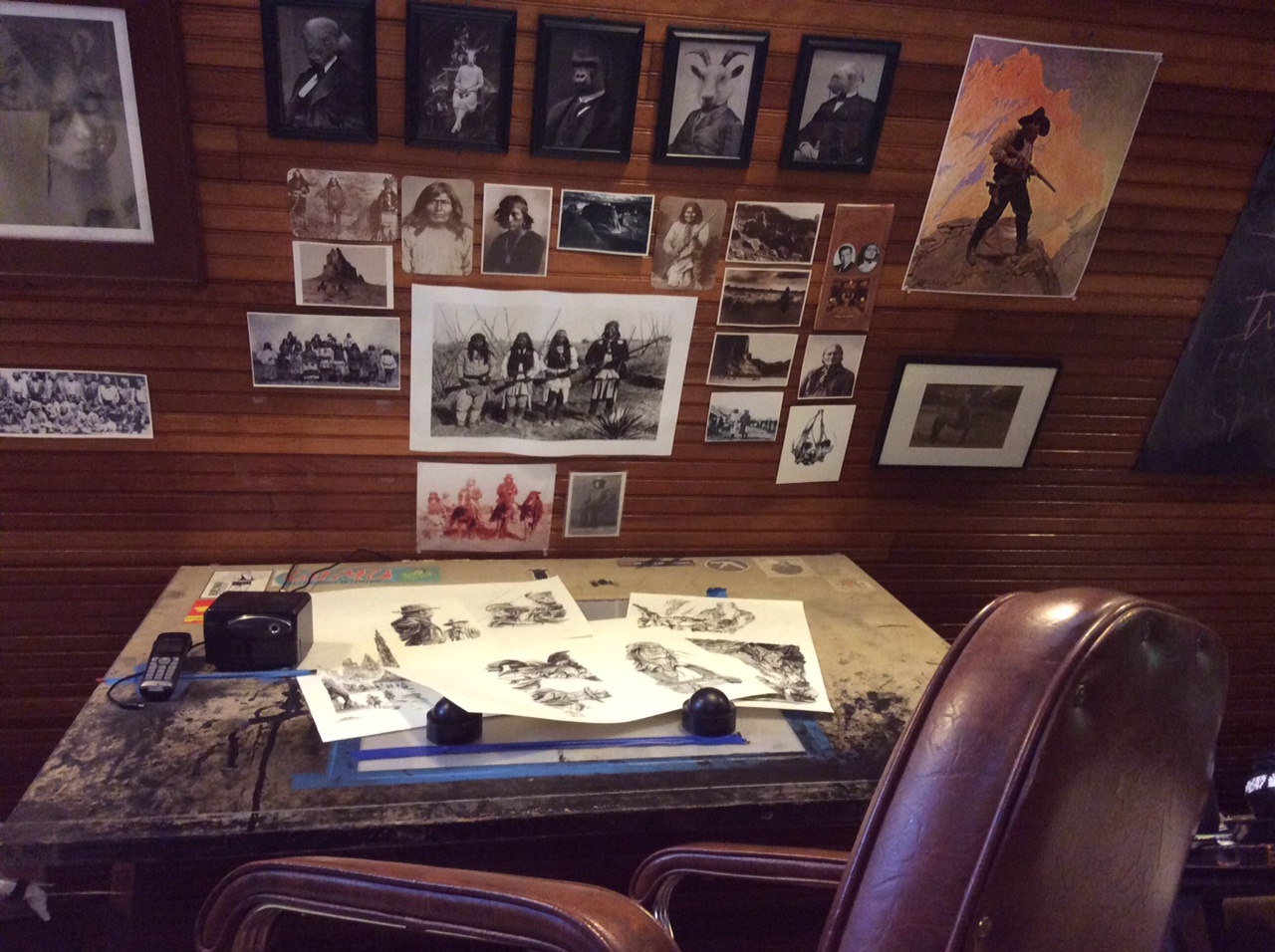 |
| INDEH central, in all its inky glory. |
Short post this week as I am in the mighty throes of finishing up the principle art for the massive graphic novel enterprise with my creative partner, Ethan Hawke , INDEH, (hitting the shelves June 2016 from Hachette/grand Central Publishing). To describe it in any other terms other than vast hyperbolic ones is not really possible for me at this stage. It’s too big, too close, too personal and too much in just about every part of myself right now. The years of research, the stacks of books and notes and the myriad of other bits and pieces are my life entirely now. So I honestly couldn’t think of anything to put down here today that wasn’t about INDEH. So I finally broke my rule to avoid David Roberts’ seminal book about the last days of the free Chiricahua, ONCE THEY MOVED LIKE THE WIND.
I made myself avoid it much in the same way I avoided Pete Dexter’s DEADWOOD until the show concluded: I didn’t want to muddy the waters. INDEH has been an organic growing creature that Ethan and I have husbanded for years now. As much as it is based upon and largely exactly accurate to its historical facts and events, we decided early on to skirt past it as a strict history, and pursue it as historical fiction instead. It freed us up to shape the story as the narrative we were constructing required, rather than recorded fact. The changes were minor, but interpretive enough to make what we were doing more dynamic more about and centered around our three core players, the legendary Chief Cochise, his son and heir, Naiches, and of course Goyahkla who would become Geronimo. It just meant in practice that we were free to have Naiches and Geronimo be at certain places for particular events that aided their story, when perhaps historically they were elsewhere. Fairly harmless inconsequential tweaks of reality that birthed massively significant story changes that made a big difference in executing our plan to make this more about them as people facing a tidal change in their world, than a simple biography or history lesson. What it meant for us personally, was that these would be our characters, or at least our take on them. Cochise is modeled after the actual fellow, as are everyone, but not entirely reflective. I gave Naiches braids and a different look to distinguish him more immediately as the medium prefers for example. Cochise was meant to look of a different time than his son or Geronimo, Mangus Coloradas from an even more ancient period, and so on. So reading Roberts’ book to early would have distorted that process. We researched the hell out of it, but mostly from dry accounts, facts anecdotes and interviews. Roberts’ book is as much a proper history as it is a work of art. I feared its influence in much the same way I panicked after reading the first five pages of Deadwood, and put it down. Until this week.
|
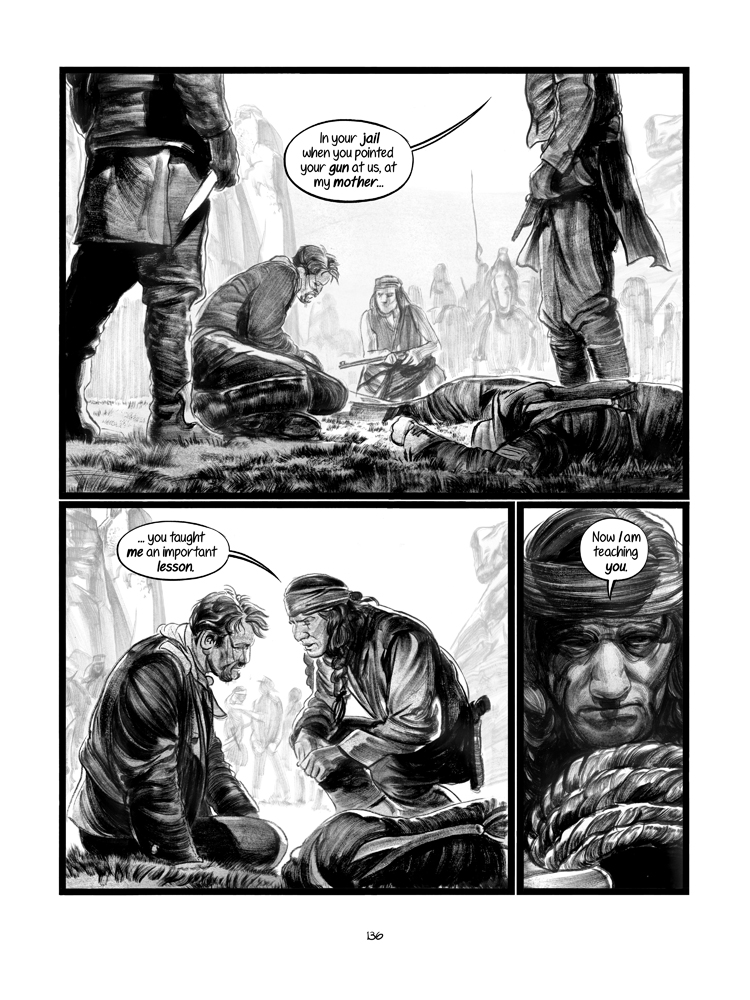 I’ll post some of the preface here below as I think it absolutely says it all for what is to come. If anything, it barely indicates the power the reader is about to witness. Our goal and our mission statement with INDEH was to break through the turgid veil of White Guilt, and the Dances with Wolves comfort blanket that we have enveloped ourselves in that neither warmed nor really comforted us in the way we hoped it might. This was and is a story we share, this terrible genocide. These were people… afraid, angry, heroic, creative, loving, terrible and beautiful as all people are and we set out to tell the story through the eyes of the Chiricahua. We decided to tell the story and end it before any of the major events that made Geronimo so legendary. This wasn’t meant to be spectacle no matter how completely spectacular a tale it was and is no matter how you tell it. What resulted was a sense of parallel invention that served only to bolster my confidence that this insane act of hubris, a couple of middle-aged white dudes from suburban Texas daring to tell one of the truly great stories of American History through the eyes of its natives, was how it turned out we were doing the selfsame thing all along. Here’s some of his preface, as both an indicator of that but more so as bait to encourage you to go out and buy a copy, and read it for yourself. I rarely insist a book on people as we all have our tastes and preferences, but for any of you who are American, this is as essential as anything ever written about our past. As Ta Ni-Hisi Coates’ new tome, BETWEEN THE WORLD AND ME is picking up the gauntlet left by Malcolm X’s autobiography, Robert’s book is that for one never until now written. And it lights a fire of interest I never expected. Still essentially a history, he structures it around the causal factors he decides, and structures when and how the events are told from that vantage. It’s more than the other usual dry referential catalogues. It’s a living tale that dives into the people and whys and hows of the times. I’ve honestly never read a book this fast before. Bolstered by its affirmation that we were telling a different take on the same events, honestly in both respects to each other made it an additive thing, rather something competitive. Here’s a bit of the preface:
I’ll post some of the preface here below as I think it absolutely says it all for what is to come. If anything, it barely indicates the power the reader is about to witness. Our goal and our mission statement with INDEH was to break through the turgid veil of White Guilt, and the Dances with Wolves comfort blanket that we have enveloped ourselves in that neither warmed nor really comforted us in the way we hoped it might. This was and is a story we share, this terrible genocide. These were people… afraid, angry, heroic, creative, loving, terrible and beautiful as all people are and we set out to tell the story through the eyes of the Chiricahua. We decided to tell the story and end it before any of the major events that made Geronimo so legendary. This wasn’t meant to be spectacle no matter how completely spectacular a tale it was and is no matter how you tell it. What resulted was a sense of parallel invention that served only to bolster my confidence that this insane act of hubris, a couple of middle-aged white dudes from suburban Texas daring to tell one of the truly great stories of American History through the eyes of its natives, was how it turned out we were doing the selfsame thing all along. Here’s some of his preface, as both an indicator of that but more so as bait to encourage you to go out and buy a copy, and read it for yourself. I rarely insist a book on people as we all have our tastes and preferences, but for any of you who are American, this is as essential as anything ever written about our past. As Ta Ni-Hisi Coates’ new tome, BETWEEN THE WORLD AND ME is picking up the gauntlet left by Malcolm X’s autobiography, Robert’s book is that for one never until now written. And it lights a fire of interest I never expected. Still essentially a history, he structures it around the causal factors he decides, and structures when and how the events are told from that vantage. It’s more than the other usual dry referential catalogues. It’s a living tale that dives into the people and whys and hows of the times. I’ve honestly never read a book this fast before. Bolstered by its affirmation that we were telling a different take on the same events, honestly in both respects to each other made it an additive thing, rather something competitive. Here’s a bit of the preface:
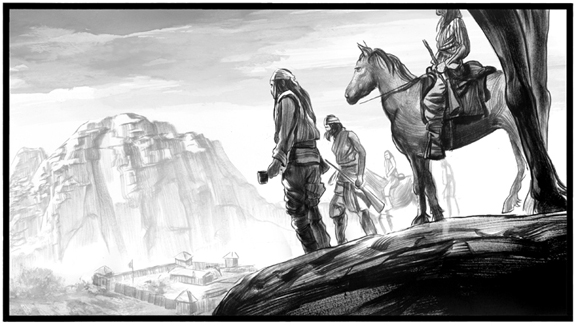 As a funny side revelation a scene from our book, chronicling the turn of the corner that ushered over a decade of terror and violence in the southwest: Cochise and his band were falsely accused of stealing a local rancher’s cattle and his adopted son, Felix Ward, who would grow to become the devilish Puck creature of this shakespearian tragedy, Mickey Free. I found that I had entirely invented a moment that turned out to be completely accurate with the facts of the day without knowing it. This is the scene: As Cochise found as his only measure of escape when the meeting in the canvas tent went south, he pulled a knife, cut the fabric and jumped out its back, still holding his coffee cup as he ran like a jackrabbit up the side of the mountain pass escaping some 55 bullets launched at him in pursuit. When he got to the top of the ridge and proclaimed, as a warning, that “Apache blood is worth the same as that of any White Eyes”, he still held that cup of coffee in his hand. I had not even for a moment heard this story until today, almost a year after having drawn that scene. I had simply thought it would be both awesome and funny to have Cochise manage to hold his coffee through this narrow escape. That the mundanity of it, the Lynchian humor that it mimicked would add a nice level of awe and humanity to the moment. I patted myself on the back for being so clever and in the end, Cochise had me beat by over a hundred years. When you’re inside a story, you start channeling it in ways you can’t quantify. If you’re lucky, you end up with a situation best cited in Alan Moore’s brilliant FROM HELL at the end when the charlatan psychic confesses all his visions about the Jack the Ripper murders were inventions: “I made it all up, and it came true anyway”. It’s one of many testaments to the magical connective power of stories and more so in this case to the utter power of Cochise and the Apaches even as we have tried so hard over the last 150 years to render them utterly powerless. Ethan and I may not get it all right in the end, and we can’t hope to match the depth and humanity of this insane period of our shared history with tribal people, but if we’re lucky we’ll get close enough to the facts to be true. Not just to mourn them, or ourselves, but to awaken them into life again and embrace them as ourselves. As our history.
As a funny side revelation a scene from our book, chronicling the turn of the corner that ushered over a decade of terror and violence in the southwest: Cochise and his band were falsely accused of stealing a local rancher’s cattle and his adopted son, Felix Ward, who would grow to become the devilish Puck creature of this shakespearian tragedy, Mickey Free. I found that I had entirely invented a moment that turned out to be completely accurate with the facts of the day without knowing it. This is the scene: As Cochise found as his only measure of escape when the meeting in the canvas tent went south, he pulled a knife, cut the fabric and jumped out its back, still holding his coffee cup as he ran like a jackrabbit up the side of the mountain pass escaping some 55 bullets launched at him in pursuit. When he got to the top of the ridge and proclaimed, as a warning, that “Apache blood is worth the same as that of any White Eyes”, he still held that cup of coffee in his hand. I had not even for a moment heard this story until today, almost a year after having drawn that scene. I had simply thought it would be both awesome and funny to have Cochise manage to hold his coffee through this narrow escape. That the mundanity of it, the Lynchian humor that it mimicked would add a nice level of awe and humanity to the moment. I patted myself on the back for being so clever and in the end, Cochise had me beat by over a hundred years. When you’re inside a story, you start channeling it in ways you can’t quantify. If you’re lucky, you end up with a situation best cited in Alan Moore’s brilliant FROM HELL at the end when the charlatan psychic confesses all his visions about the Jack the Ripper murders were inventions: “I made it all up, and it came true anyway”. It’s one of many testaments to the magical connective power of stories and more so in this case to the utter power of Cochise and the Apaches even as we have tried so hard over the last 150 years to render them utterly powerless. Ethan and I may not get it all right in the end, and we can’t hope to match the depth and humanity of this insane period of our shared history with tribal people, but if we’re lucky we’ll get close enough to the facts to be true. Not just to mourn them, or ourselves, but to awaken them into life again and embrace them as ourselves. As our history. 

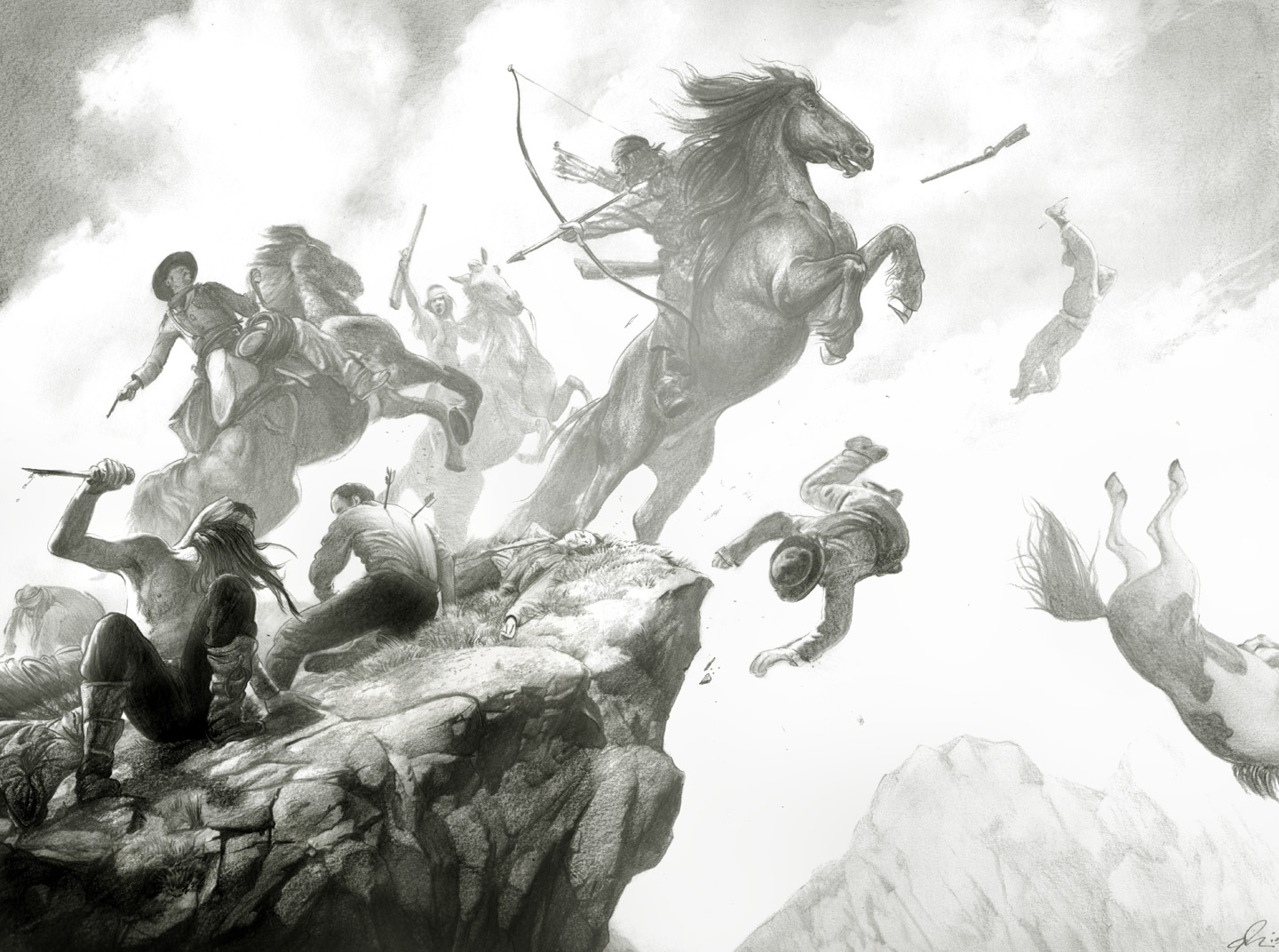
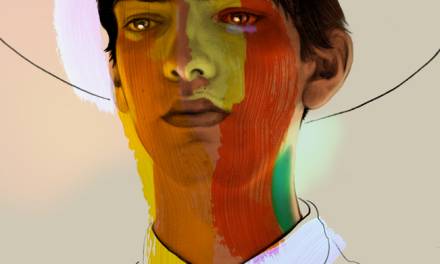
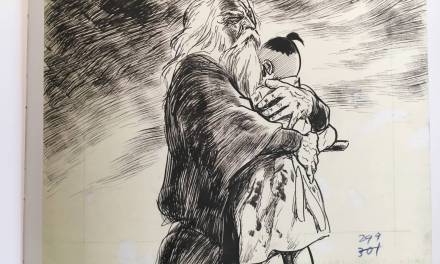
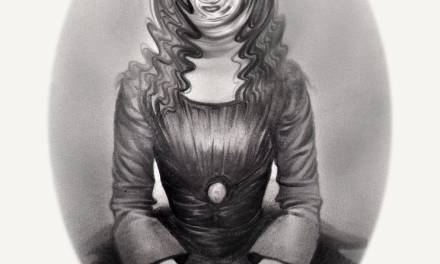
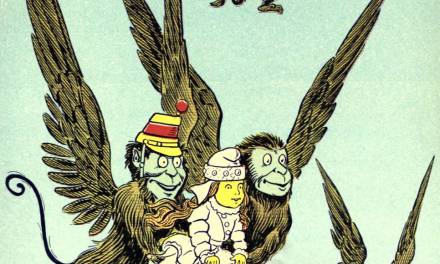

Very intriguing and well written post. Living and painting in the southwest for some time now, I believe that one can really feel the history in the land out here. I greatly look forward to INDEH and thanks for all the info. Cheers
There's something really powerful about that part of the country. The landscape is so vast and huge, it just sets the stage for big things and feeling tiny. When Ethan and I took a research trip out there, it was like being inside a dream. Hope we can meet your expectations with the book. We're pretty excited.
Epic